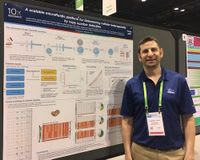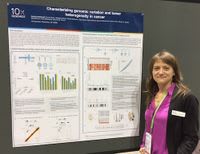#AACR18 Day 3 - Single Cell Analyses Reveal Tumor Heterogeneity & Inform Novel Treatment Development
AACR 2018 might be more than halfway over, but it didn’t show any signs of slowing down today. It was another jam-packed day full of highlights, starting with a Symposium on tumor cell fate and treatment response. "Dharma Master Jiantai Symposium in Biomarkers: Insights into Tumor Cell Fates and Drug Resistance from Single-Cell Analyses," led by Caroline Dive, Cancer Research UK Manchester Inst, featured some really interesting talks about single cell research, including:
- "Deciphering intra-tumoral heterogeneity by single cell RNA sequencing" by Itay Tirosh, Weizmann Institute of Science
- "Single-cell analysis of therapy resistance in cancer" by Arjun Raj, University of Pennsylvania
- "Molecular analysis of circulating tumor cells: A single cell-based liquid biopsy biomarker of chemo response" by Caroline Dive
After the morning presentations, I spent the rest of the day with the posters. I started off with "Novel approaches to high-affinity TCR isolation for clinical translation enabled by single cell RNA sequencing," presented by Megan McAfee, Fred Hutchinson Cancer Research Center, which describes the authors’ research using the Chromium Single Cell Immune Profiling Solution to rapidly identify rare, high-affinity TCRs from limited samples. These highly avid paired TCRs can then be isolated and applied in the development of therapies.

Then, I decided to check out a pair of 10x-pert posters about our new Chromium Single Cell CNV Solution. The first, "A scalable microfluidic platform for determining cellular heterogeneity by copy number detection," presented by Andrew Price, showcased our new solution and its potential as a tool for mapping heterogeneity in cancer, discussing how it’s results were validated. The authors used several methods to validate, including measuring the system’s CNV calls against orthogonal data from well-characterized cell lines, including RPMI8226, HCC1954, and HCC1143. In this case, they observed high concordance.

The second poster was "Characterizing genomic variation and tumor heterogeneity in cancer," presented by Claudia Catalanotti, which discussed the use of the Single Cell CNV Solution in conjunction with the Chromium Genome Sequencing Solution to more fully examine genetic variation in cancer samples. By running the same samples on both systems, the authors were able to analyze and compare the variations revealed by each approach, giving them a more complete understanding of tumor genome dynamic.
My next stop was "Single-cell RNA sequencing identifies macrophage-specific expression signatures associated with phagocytosis of multiple myeloma after treatment with cIAP antagonist," presented by Nicholas Banovich, Translational Genomics Research Institute, which outlined research on the effects of LCL161 treatment in mice with multiple myeloma (MM). The authors used the Chromium Single Cell Gene Expression Solution to profile 90,000 individual cells from 18 mice spleens—7 WT mice and 11 mice with VK12598 transplanted myeloma. Of the 11 mice with tumors, three were treated with LCL161, each displaying a significant decrease in tumor cells. Upon further analysis, the authors observed that LCL161 treatment upregulated genes and activated pathways in the tumor-bearing mice that could prove useful in the development of novel therapies for MM.
I made my way to "Linked read whole genome sequencing reveals pervasive chromosomal level instability and novel rearrangements in brain metastases from colorectal cancer," presented by Li Xia, Stanford University, to learn more about their study using the Genome Sequencing Solution to better understand the genomic underpinnings of brain metastases from colorectal cancer (CRC). With Linked-Reads data, the authors were able to generate megabase-scale haplotypes, allowing them to discover large-scale chromosomal rearrangements that may be a contributing factor in brain metastases from CRC.
Last on my agenda for the day was "Integrated single-cell DNA and RNA analysis of intratumoral heterogeneity and immune lineages in colorectal and gastric tumor biopsies," presented by Billy Lau, Stanford University School of Medicine, which examined a new approach for measuring both intratumoral heterogeneity and immune response to a tumor. The authors used the Single Cell Gene Expression and Single Cell CNV Solutions in parallel, allowing them to perform both scDNA-seq and scRNA-seq on their tumor samples. As a result, they had access to copy number and chromosomal aneuploidy data from scDNA-seq as well as subpopulation information from scRNA-seq. Overall, their study indicates the potential promise of integrated scDNA-seq and scRNA-seq testing on patient tumors.
Check back in for my update on the last day of AACR 2018!
